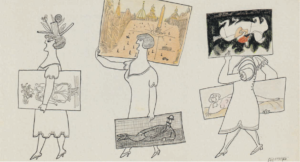The Italian lack of awareness
 A specific feature of Italy seems to be what has been called the “Italian unawareness”, which brings with it a lack of public debate and collective historical reflection on the themes of racism and antisemitism. Not having dealt with its own racism (on the contrary wanting to build a collective image on the idea of openness, tolerance), Italy therefore tends “to legitimize, justify, and diminish the seriousness of the forms of antisemitism and racism, contributing thus to legitimize their dissemination”.
A specific feature of Italy seems to be what has been called the “Italian unawareness”, which brings with it a lack of public debate and collective historical reflection on the themes of racism and antisemitism. Not having dealt with its own racism (on the contrary wanting to build a collective image on the idea of openness, tolerance), Italy therefore tends “to legitimize, justify, and diminish the seriousness of the forms of antisemitism and racism, contributing thus to legitimize their dissemination”.
“There is an assumption that makes intolerances, and antisemitism in particular, particularly specific to Italy and that is the extreme average unawareness of the average Italian. […] I would say because it is denied and jammed by the official exclusivity of the Catholic Church. Even if at the beginning it is anticlerical, it is then further reduced by the Italian unification a century and a half ago, let’s say by the monarchy. It is already an antechamber of the simplifications of fascism and, in reality, there is very little tradition of pluralism and dialogue”.
For many in Italy there is an antisemitism that could be defined as ‘low intensity’, which is however pervasive and continually put into circulation, given the unwillingness to criticize it and to highlight its forms and social consequences. A ‘low intensity’ antisemitism does not at all mean an antisemitism without consequences or less dangerous: it is precisely the fact that it becomes common sense that makes it dangerous because it ends up derubricating acts of antisemitism and racism as ‘normal’, unintentional, harmless things, and jokes without consequences.
“Antisemitism adapts to the novelty of a less significant Jewish presence on the European continent, almost extinct with the French exception and with the significant return of Jews to Germany. However, we are talking about hundreds of thousands and no more millions of people. […] the Jew of Europe is a brutally endangered figure”.
Few respondents, Guetta explains, “have a perception of the trends (of growth or decrease) of antisemitism in Europe or Italy”. Some, especially on the right, “think that antisemitism is less widespread in Italy than in other European countries”. “My perception is that in Italy it is a phenomenon perhaps present at the social level, at the level of individuals, but that it is not structured as a phenomenon”.
“I don’t know enough about European reality except what I can read in the newspapers, certainly we are better off than in some Eastern countries, there is no doubt about this. In France there have been more ‘street’ episodes, so to speak: the attack on the boy with the kippah. Among other things, in France it is not that antisemitism is disconnected from racism in general”.
“I believe that Italy is a nation in which fortunately cases of antisemitism are less widespread, in the sense that the Italian people are absolutely not anti-Semitic in my opinion and there is a historical friendship with the Jewish people. Sometimes problems arise or are starting to arise also due to problems related to immigration, at times uncontrolled, which leads to having within our territory people who were born and raised with different cultures and who sometimes risk carrying on with them the phenomena of antisemitism”.
Above, image from the catalog of the exhibition “Saul Steinberg Milano New York” curated by Italo Lupi and Marco Belpoliti with Francesca Pellicciari and realized with the Electa publishing house.
